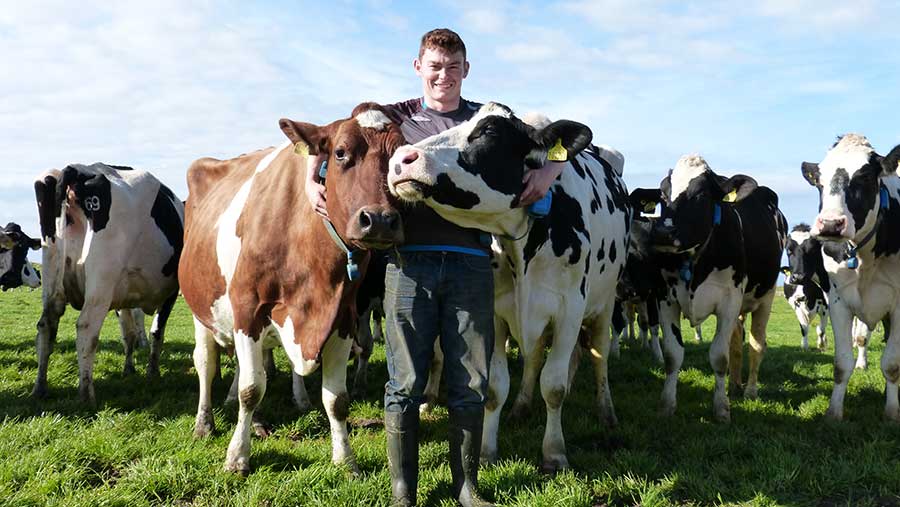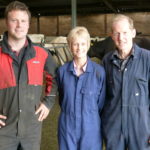Feeding waste whey helps Scottish dairies on milk cost
 © Michael Priestley
© Michael Priestley A novel use for a creamery by-product has proved popular with Kintyre dairies by helping them increase milk quality, dry matter intakes and offering a daily saving of 33p a cow.
Using whey permeate in February and March this year was a win-win for both dairy farmer and dairy, with First Milk able to produce a tonne of cheese with 366 litres less milk as a result of higher milk casein levels.
See also: First Milk farmers to add value through casein project
By incorporating the product into forage-based total mixed rations (TMRs), First Milk producers cut molasses from their feed bill, while avoiding the perennial issue of a seasonal dip in milk fat and protein components.
Importantly, this either lifted milk protein by 0.02-0.05%, of which 75-80% was casein, or held it steady at a time of year when protein typically drops.
At Machrihanish Farm, Campbeltown, Sandy, Joan and John Pirie saved on 1 litre of molasses and also 1kg of soda wheat per cow per day from their TMR across the 180-cow herd of predominantly Holstein-Friesians.
SAC dairy adviser David Keiley calculated an overall saving of £42 a cow, when accounting for the costs of whey at £24/t for a 220-day winter across the cows giving 9,000 to 10,000 litres when challenged.
Machrihanish Farm Savings
Total savings from feeding whey, cutting 18.5p of molasses/urea blend and soda wheat at 15.2p = 0.337p a cow a day x 180 cows = £60.66. = £13,345.20 over 220 days
Total Expenditure on whey @ 6 litres per cow (£24/1,000 litres) 0.144p x 180 cows = £25.92 = £5,702.40 over 220 days
Total Net saving = £7,642.80
Net savings of 0.64 pence a litre based on 180 cows producing 30 litres a day average = 1,188,000 litres over a 220 day winter
Based on £7642.60/1,188,000 x 100 = 0.64p/l
Costs based on a winter 2015/16 price of Whey permeate £24/t; Molasses £180/t; Soda wheat £157/t . Cow would have eaten an extra 3-4kg fresh weight silage at £25/t.
“We would be keen to use the whey permeate again, it lifted our dry matter intakes and the cows were definitely cudding more,” says Sandy.
“In winter we see protein and butterfat drop in mid-January and start to fall way down, there is normally a two-month lag after the cows come inside.
However, rather than falling further, butterfat and protein actually increased with the whey permeate in February and March.”
The Piries feed TMR every day of the year at Machrihanish, mixing homegrown cereal, wholecrop and forage in a 2.5t wagon. Cows access TMR from feed passages and a bunker.
Cows were rationed to yield 45 litres a day and were fed 35kg of freshweight silage, 5kg fermented wholecrop, 5kg of distillers draff, 2.5kg of caustic wheat, 1.5kg of 34% crude protein blend, 1kg of molasses/urea blend and 12.54kg of an 18% standard cake.
According to son John, there was no problem getting cows to switch onto the new TMR, although he says low DM silages would become too wet and difficult to feed.
Mr Keiley explains that milk from forage improved, with 3-5kg more freshweight consumed a day.
“Yield stayed the same on a litres basis, but protein at 3.19% and casein at 2.445% rather than seeing the usual seasonal fall,” he says.
In addition to the Piries, the Ralstons at Dhurrie Farm, the Ralstons at East Drumlemble, and Dougal and James Young, The Drum, all had positive experiences with the additive.
The Grahams at West Backs had a mixed experience with the whey because of diet alterations, but did manage a casein lift in their milk.
Decision time
Mr Keiley oversaw the Scottish Funding Council funded trial of five farms in February and March 2016 through the SAC Campbeltown office after Chris Wareham, site manager of First Milk’s Campbeltown creamery, hatched the idea of feeding whey permeate to boost milk quality.
“Producing milk with high enough protein levels is typically a challenge through the winter,” explains Mr Wareham, underlining the importance of casein levels, cheese quality and plant efficiency.
“Getting more protein in milk is the best and easiest way to improve cheese quality,” he adds.
The plant provided and delivered the whey free from Campbeltown. Previously, the substance was hauled to Aspatria, Cumbria, to a bio-digester, but a further option is being looked at closely, a joint-venture protein extraction and drying operation.
Whey was delivered to farms three days a week (Monday, Wednesday and Friday) into Intermediate Bulk Container (IBC) tanks by milk tankers, both of which needed cleaning between deliveries. IBC tanks were raised on pallets to fill forage wagons.
“Farmers quickly became able to gauge how much whey was needed,” explains Mr Keiley. “About half a cube was enough for 100 cows.”
Feeding whey permeate also reduced creamery haulage costs and savings on Skimmed Milk Powder, which is added to milk during the winter to increase protein levels when component production on farm drops.
Heading into the winter, the farms are keen to use the additive again, but Mr Wareham stresses the focus is on 100% supply to the joint venture this winter.
“It put a bloom on the cows”

Tommy, Elaine and Craig Ralston, Dhurrie Farm, 40 pedigree Jersey cows averaging 5% butterfat and 4.13% protein and 90 pedigree Holstein-Friesians giving 3.95% butterfat and 3.3% protein on 72ha.
The Ralstons say adding 6 litres of whey permeate to diets saw intakes and cow condition improve. TMR is fed at a flat rate once a day at Dhurrie Farm, with homegrown silage and pushed up six to seven times a day.
Tommy says: “We saw intakes go up straight away, there was no difficult transition onto it and the cows benefited as result.
“They held condition better, it put a bloom on the cows and they went out to pasture in better order. The protein levels held but the volume of casein in the tank went up as a percentage of that protein.
“With limited acreage we struggle to put more cows on the farm, so instead focus on milk quality, and that is partly why we went into Jerseys. I would feed whey permeate again but it comes down to price. If it helps us produce milk the creamery wants, it’s a good thing.”
Winter TMR Ration
33kg grass silage
10.5kg distillers draff
5kg soda wheat
1kg soya
1kg wheat dark grains
0.15kg minerals
0.05kg limestone flour
1 litre of molasses (replaced with 6 litres of whey permeate)
Practical feeding
Applied at 6 litres a cow, Mr Keiley says whey permeate can work as a TMR additive eight months of the year, complementing the system of the five Kintyre farms, which feed TMR every day to year round calving, flat profile herds.
However, he admits there is a minor snag to summer feeding so use would be limited to eight months of the year.
“It’s a sweet product and this attracts flies,” he explains. “However, while an ambient temperature would ferment the whey, the nutritional value remains the same.
“The permeate is particularly useful through the winter when protein levels drop in the milk and in the winter keeping it on farm is not a problem.”
Mr Keiley notes milk protein levels are 55% down to genotype and 45% down to management. “Farmers can now select Kappa-casein bulls, which on some contracts will be more advantageous than selecting for litres. With the market moving to solids, these bulls will become more important.”
On the management side, Mr Keiley prescribes high starch diets and good intakes of quality forage to maintain components through the shoulders of the season.
“Forage intakes lifted”

Murray, Andrew, Willie and Catherine Ralston, East Drumlemble, 220 Ayrshire-cross Red and White herd giving 7,250-7,500 litres when challenged across 128ha growing barley and wheat for a homegrown total mixed ration.
Improved fertility and a lift in protein have been two benefits noted by the Ralston family, East Drumlemble.
TMR is fed all year round at a flat rate with nothing fed at parlour. A 24m cubed forage wagon with twin augers delivers TMR once a day. Since feeding whey permeate the Ralstons saw protein lift 0.02-0.05% at a time when protein usually decreases.
Andrew says: “You really need a dry silage, which we managed last year. A 29DM would be fine, but much below this and it would turn into a bit of slush in the feeder wagon. If you’re in a situation like ours and your milk is going for cheese and components matter, then feeding whey permeate works.”
Willie adds: “Our conception rate was around 45% and it lifted to 50%. Fertility improved and bulling behaviour was good when they were eating the whey but this could be down to the cows getting over fluke.
“This can be an issue here at times as we get over 1.5m of rain a year. Forage intakes lifted because of the whey and remained consistently good.”
Winter TMR Ration
42kg grass silage
4.5kg distillers draff
2.5kg hypro-soya
2kg treated barley
2kg crimped wheat
0.5kg straw
0.2kg rumen protected fat and calcium
0.15kg minerals
1 litre of molasses (replaced with 6 litres of whey permeate)
